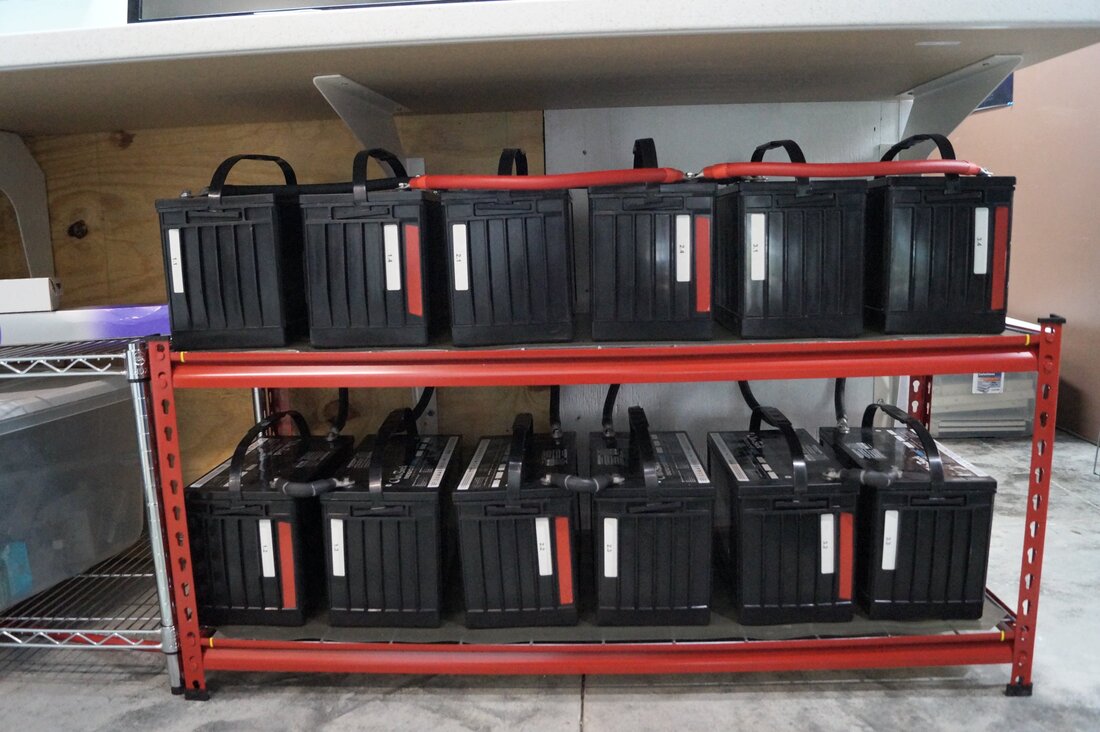It's been almost three years since my original post on Photovoltaics and just about a year since we installed our system. With a year of experience it's a good time to post some results. This report will outline the equipment selected and future reports will describe installation and performance.
Batteries
As mentioned in the previous post, I wanted a hybrid system that would include sufficient battery backup to run our critical circuits (refrigerator, well, microwave, networking) for at least 24 hours. Based on several years of monitoring the critical circuits, the battery bank would have to provide a minimum of 10 kWh.
I investigated Tesla Power Wall and LG RESU Lithium-ion batteries. Although lithium-ion batteries have a much longer service life than old-tech lead-acid batteries the cost is far greater. Since we only use the batteries for backup, service life (i.e. the number of charge-discharge cycles) is not an issue. I intentionally discharge the batteries once every 3-4 months just to verify they are functioning properly. Aside from that we have only had a couple of outages which were an hour or less.
I selected the Outback 106NC battery which stores approximate 100 Amp-Hours at 12 Volts. Since the batteries cannot be fully discharged they provide a bit less than 1 kWh of backup power per battery. To achieve the required 10 kWh of reserve power I went with 12 batteries arranged as three banks of 4. At a cost of $245/battery (with free shipping) the total cost was just under $3,000.00, which was about 1/4 the cost of an equivalent RESU or Power Wall.
Unfortunately, it appears that this series has been discontinued.
One side benefit is that the individual batteries are "only" 69 lbs each so I was able to schlep them into the basement and wire them together to save on installation cost.

A hybrid system is more complex than a grid-tied system with micro-inverters. It must be able to function in both grid-tied and off-grid modes. It must include a battery charger/controller and a central inverter that operates at battery voltage (48 volts in our case).
It's also nice if the system has a provision for a 240v backup generator to recharge the batteries if there's insufficient sunlight.
At the time, there were only two integrated hybrid controllers available:
- The Outback SkyBox outbackpower.com/products-mobile/category/skybox
- The Sol-Ark 8K www.sol-ark.com/sol-ark-8k-hybrid-all-in-one/
The specs on the Sol-Ark are superior... the inverter supports 8kW versus 5kW for the SkyBox and the Sol-Ark is more efficient. However, Sol-Ark was/is a relatively young company so I decided to go with SkyBox.
Sol-Ark is a better value and has received outstanding reviews over the past year. I would probably select Sol-Ark if I were installing a system today.
Solar Panels
Our design calls for a 6kW array with somewhat limited roof space. This requires panels with a relatively high efficiency (at least 18%).
I really wanted to purchase Hanwha Q.Peak panels since Hanwha produces them at a new factory in Dalton Georgia. Unfortunately all of their production was being consumed to build a huge solar farm to power a new Facebook server facility being built in Georgia. Interesting story here - www.npr.org/2019/06/24/733795962/how-georgia-became-a-surprising-bright-spot-in-the-u-s-solar-industry
I selected REC N.Peak 320 Watt panels since they are based on the same half-cut cell technology as Q.Peak (the two companies are in patent litigation over the similarity). www.recgroup.com/en/products/rec-n-peak-en
Last year we paid $215.00 per panel or about $0.67 per Watt. This was a really great price for panels that offer an efficiency greater than 19%. The panels are at $211.00 today so not much has changed and they remain an excellent value.
Rec has now introduced the new Alpha series that deliver 21% efficiency. However the price is much greater. A 365 Watt panel costs $345.00 or about $0.95/Watt. You should expect to pay a substantial premium for a bit greater efficiency.
In the next report I'll describe the installation process.



 RSS Feed
RSS Feed